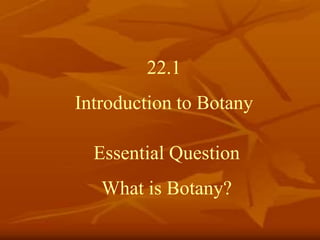Report
Share

Recommended
More Related Content
Similar to 22.1_Intro to Botany.ppt
Similar to 22.1_Intro to Botany.ppt (20)
Determining State And Federal Wetland Jurisdiction Determining State and Fed...

Determining State And Federal Wetland Jurisdiction Determining State and Fed...
BIO 2203 Lecture 1 Introduction, Scope and Cells, tissues (NXPowerLite Copy)...

BIO 2203 Lecture 1 Introduction, Scope and Cells, tissues (NXPowerLite Copy)...
Recently uploaded
Molecular and Cellular Mechanism of Action of Hormones such as Growth Hormone, Prolactin, InsulinMolecular and Cellular Mechanism of Action of Hormones such as Growth Hormone...

Molecular and Cellular Mechanism of Action of Hormones such as Growth Hormone...Ansari Aashif Raza Mohd Imtiyaz
Antibiotics are medicines that fight infections caused by bacteria in humans and animals by either killing the bacteria or making it difficult for the bacteria to grow and multiply. Bacteria are germsABHISHEK ANTIBIOTICS PPT MICROBIOLOGY // USES OF ANTIOBIOTICS TYPES OF ANTIB...

ABHISHEK ANTIBIOTICS PPT MICROBIOLOGY // USES OF ANTIOBIOTICS TYPES OF ANTIB...ABHISHEK SONI NIMT INSTITUTE OF MEDICAL AND PARAMEDCIAL SCIENCES , GOVT PG COLLEGE NOIDA
Recently uploaded (20)
Heat Units in plant physiology and the importance of Growing Degree days

Heat Units in plant physiology and the importance of Growing Degree days
Adaptive Restore algorithm & importance Monte Carlo

Adaptive Restore algorithm & importance Monte Carlo
Mining Activity and Investment Opportunity in Myanmar.pptx

Mining Activity and Investment Opportunity in Myanmar.pptx
Molecular and Cellular Mechanism of Action of Hormones such as Growth Hormone...

Molecular and Cellular Mechanism of Action of Hormones such as Growth Hormone...
Information science research with large language models: between science and ...

Information science research with large language models: between science and ...
Film Coated Tablet and Film Coating raw materials.pdf

Film Coated Tablet and Film Coating raw materials.pdf
Manganese‐RichSandstonesasanIndicatorofAncientOxic LakeWaterConditionsinGale...

Manganese‐RichSandstonesasanIndicatorofAncientOxic LakeWaterConditionsinGale...
ANITINUTRITION FACTOR GYLCOSIDES SAPONINS CYANODENS

ANITINUTRITION FACTOR GYLCOSIDES SAPONINS CYANODENS
ABHISHEK ANTIBIOTICS PPT MICROBIOLOGY // USES OF ANTIOBIOTICS TYPES OF ANTIB...

ABHISHEK ANTIBIOTICS PPT MICROBIOLOGY // USES OF ANTIOBIOTICS TYPES OF ANTIB...
MSC IV_Forensic medicine - Mechanical injuries.pdf

MSC IV_Forensic medicine - Mechanical injuries.pdf
Vital Signs of Animals Presentation By Aftab Ahmed Rahimoon

Vital Signs of Animals Presentation By Aftab Ahmed Rahimoon
Fun for mover student's book- English book for teaching.pdf

Fun for mover student's book- English book for teaching.pdf
22.1_Intro to Botany.ppt
- 1. 22.1 Introduction to Botany Essential Question What is Botany?
- 2. • Botany is the study of plants. • Areas of botany: – Plant Anatomy and Physiology – Plant Taxonomy – Plant Geography – Plant Ecology – Plant Genetics – Plant Cell Biology – Economic Botany – Ethnobotany What is botany?
- 11. Generalized Plant Life Cycle
- 20. Cont’d •Plants also grouped according to how they obtain water. •Vascular plants have tube-like structures that transport water from the roots to the leaves. •Nonvascular plants can only absorb water through their roots.
- 21. Nonvascular plants •Nonvascular plants or bryophytes are found in moist areas because they do not have long roots to absorb water. •They are usually less than 20 cm tall. •Three classes: •Mosses •Liverworts •Hornworts
- 22. Flowering plants Cone-bearing plants Ferns and their relatives Mosses and their relatives Green algae ancestor Flowers; Seeds Enclosed in Fruit Seeds Water-Conducting (Vascular) Tissue Section 22-1 Figure 22–6 A Cladogram of Plant Groups Go to Section:
- 23. Cone-bearing plants 760 species Ferns and their relatives 11,000 species Mosses and their relatives 15,600 species Flowering plants 235,000 species Section 22-1 Figure 22-7 The Diversity of Plants Go to Section:
- 24. Cont’d •Plants also grouped according to how they obtain water. •Vascular plants have tube-like structures that transport water from the roots to the leaves. •Nonvascular plants can only absorb water through their roots.
- 28. Vascular Plants •Two categories: •Gymnosperms – bear seeds in cones; pine trees •Angiosperms (Flowering) – largest category- bear seeds in flower
- 30. Angiosperms Commonly called flowering plants Two types: monocots – one seed leaf dicots – two seed leaves Fruit – ripened ovary of a flower Includes trees, grasses, and shrubs
- 31. First Plants •Oldest fossils (450 million years) show that earliest plants were similar to today’s mosses •Early plants depended on water for reproduction •Over time plants evolved adaptations that allowed them to reproduce without water and also to exist in a wide range of terrestrial environments.
- 32. 1. First plants evolved from multicellular green algae. 2. These algae have the size, color, appearance of plants 3. Reproductive cycles of algae like plants 4. Cell wall and pigments of algae identical to plants Origins in water
- 33. •.
